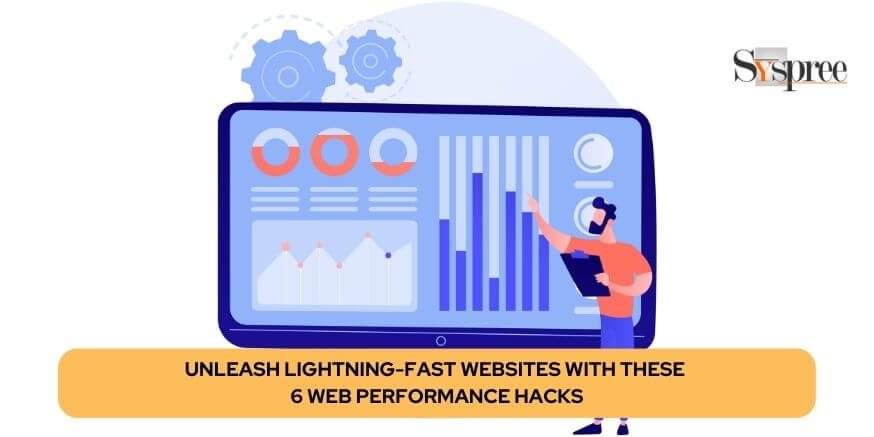In the current fast-paced digital age, where users need more patience with slow-loading websites, having a fast-loading website is essential to success. A leading web design company in Mumbai states that the slow loading times of your website not only make visitors feel frustrated but can also result in more bounce rates, lower rate of conversion, and ultimately a negative impact on your business.
Key Takeaways:
- Web performance is essential for user satisfaction, rankings on search engines, and conversion rates. It includes page load times and responsiveness, interactivity and stability.
- Factors that impact web performance include the design and structure and the performance of servers, conditions on networks and the usage of Content Delivery Networks (CDNs).
- Web performance measures include page load times time to first bytes (TTFB) rendering start time, dimensions of the web page and an estimate of the number of HTTP requests.
- Optimizing the load time of websites involves the reduction of HTTP requests and optimising pictures and audio and video content, decreasing response times to servers, and utilizing CDNs.
- Speeding up the rendering of websites can be accomplished by reducing rendering-blocking resources, prioritizing over-the-fold content, delaying JavaScript execution and improving CSS delivery.
Understanding Web Performance
Web performance is the speed and effectiveness of when the website loads and performs in addition to the user experience that it offers. It covers various aspects, including page load speed and responsiveness, interactivity and general stability of the website.
A properly-functioning site improves the user experience and helps improve ranking on search engines and conversion rates. Allow a brilliant digital marketing company to guide you in understanding web performance.
Factors Affecting Web Performance:

Factors Affecting Web Performance
Many elements can affect web performance. Let’s examine some of the key elements:
- Site design and structure design and the structure of a site can dramatically affect web performance. A well-optimized HTML, CSS, and JavaScript code, effective utilization of pictures and media file formats, and general organization information can help speed up load times and more fluid user interactions.
- The performance and efficiency of the server hosting the website are crucial. Factors such as server response time as well as bandwidth, capacity of the server, and server location can affect the speed at which the website can provide content to users.
- Content Delivery Network (CDN) can increase web browsing speed by caching web content on servers close to the users. This can reduce the distance the data must travel and result in quicker loading times.
1. Metrics for Measuring Web Performance:
To measure and improve web performance. It is essential to determine relevant indicators. Here are the most important metrics that are commonly used:
- Page Load Time: This measurement determines the time required for a page to fully load on a user’s browser. Speedier page load times typically result in better user interaction and lower bounce rates.
- Timing to the First Byte (TTFB): The time the server requires to send the first bytes of data to respond to the user’s request. It is a measure of server responsiveness and delay in the network.
- The Render Time Start: This measurement is when the browser user starts rendering the page. It determines when the website is accessible to the viewer.
- Total Page Size: The measurement is the sum of all files required to load a page which includes HTML, CSS, JavaScript images, and various other types of media. Reduced page size can aid in improving the speed of loading.
- The number of HTTP Requests: This number measures the number of requests made by the browser to obtain all necessary files required to render a page. Reducing the number of requests can result in faster loading.
2. Optimizing Website Load Time
The time to load a website is an essential aspect that significantly impacts the user’s satisfaction, engagement and overall business success. A top web design company states that website speed is one of web performance’s most essential aspects.
Minimizing HTTP Requests:
One of the main factors contributing to slow loading speeds is how large the browser makes the number of HTTP requests to download resources like HTML, CSS, JavaScript images and various other types of files. To limit the number of requests:
- Combining CSS and JavaScript documents reduce the number of external CSS and JavaScript files by combining them into fewer files. This decreases the number of round-trips required to get resources.
- CSS Inline the crucial CSS directly in the HTML document to prevent additional CSS requests and improve the rendering.
- Use CSS sprites to combine several small images into one sprite sheet, reducing the number of requested images. Use CSS positioning to display the necessary parts in the sprite sheet.
Optimizing Images and Multimedia Content:
Photos and multimedia files add significantly to the size of a page and can affect loading times. In order to maximise these resources:
- Utilize techniques for compression to minimize file size without sacrificing quality. Resize images according to the needed dimensions, and avoid too large images, which slows down loading time.
- Choose the best image format to suit the situation. JPEG is perfect for photos; however, PNG and SVG are better suited for logos and graphics.
Reducing Server Response Time:
The time it takes for server response, referred to by the term Time to First Byte (TTFB), is crucial for the speed of user experience. To speed up server response times:
- Ensure that the server is correctly configured and has optimized settings for caching, compression and allocation of resources.
- Use server-side caching methods, such as caching databases, content caching, and object caching, to limit dynamic content creation and retrieval processes.
Implementing Browser Caching:
Using browser caching lets returning users load your website faster, as they can store static resources locally. To use browser caching:
- Set caching headers: Configure HTTP headers such as Expires, Cache-Control and ETag to determine the length of time that the browser will store resources. Utilize tools such as mod_expires or caching plugins that simplify the process.
- Utilize fingerprinting or versioning: Apply versions or unique identifiers to URLs of resources to make it easier for the browser to get the latest version every time modifications are made.
Utilizing Content Delivery Networks (CDNs):

Content Delivery NetworksContent Delivery Networks distribute your website’s static resources over multiple servers across the globe, which reduces the distance data has to travel. This leads to quicker loading times for users from different regions. To leverage CDNs, choose a reliable CDN provider that provides global coverage and efficiently delivers content.
3. Enhancing Website Rendering Speed
The best digital marketing agency in Singapore believes that the speed of website rendering plays an important role in providing an effortless and enjoyable user experience.
Minimizing Render-Blocking Resources:
The rendering blockers, like CSS and JavaScript documents, which are needed to render the web page, can significantly impact rendering speed. To reduce their impact:
- Critical CSS inline incorporates the necessary CSS directly in the HTML document to remove the requirement for additional CSS requests. This lets the browser begin rendering the page immediately without waiting for stylesheets from outside.
- Load CSS Asynchronously by using the “async”, “async”, or “defer” attribute to include the external CSS files. This lets the browser keep parsing and rendering the web page while downloading all the CSS within the background.
Prioritizing Above-the-Fold Content:
Above-the-fold content refers to the area of your website that is initially visible to the user without scrolling. Prioritizing the loading of above-the-fold content can dramatically increase the speed at that users perceive your site. To do this:
- Critical above-the-fold inline CSS Embed the CSS styles needed to render the above-the-fold content inside the HTML document. This enables the browser to render the content quickly, even before stylesheets external to the browser are loaded.
Deferring JavaScript Execution:

JavaScript Execution
JavaScript execution can be a performance bottleneck, particularly if it impedes rendering. To optimize JavaScript execution:
- Transfer JavaScript down to the bottom. Then, place JavaScript files before that closing tag. Then, the essential rendering route is not impeded due to JavaScript execution.
- Defer the non-essential JavaScript. If you are looking for a not essential JavaScript functionality, you can use”async” or the “async” or “defer” attribute.
Optimizing CSS Delivery:
A speedy CSS delivery is vital for faster rendering. Think about the following optimization strategies:
- Minimize CSS files by eliminating comments, whitespace, and irrelevant code. Compressing CSS will further reduce the size of files and speeds up loading.
- Reduce the number of CSS files by joining them into one file. This decreases the number of HTTP requests required to retrieve CSS resources.
4. Improving Mobile Performance
Responsive web design is the most important factor in designing mobile-friendly websites. A leading web design company in Mumbai says mobile optimization lets your site adjust and alter its layout to match the screen’s size and the device’s orientation. To implement responsive design:
- Use CSS media queries to apply CSS styles that differ according to the screen size and allow your site to alter its layout and content presentation accordingly.
- Begin creating your site keeping mobile-friendly devices in the back of your mind, and later, gradually improve the experience for larger screens. This method ensures an effortless and optimized experience for mobile devices.
Optimizing Images for Mobile Devices:
The most efficient digital marketing company suggests image optimization. Images can significantly impact mobile devices’ performance due to their large size of files. To optimize images for mobile devices:
- Utilize techniques for compression to reduce the size of files without sacrificing visual quality. Tools and libraries such as JPEGmini, ImageOptim, and Kraken.io can help optimize images efficiently.
- Serve appropriately sized images. Use responsive image techniques to serve images that are appropriate for various gadgets.
Enabling AMP (Accelerated Mobile Pages):
AMP is an open-source framework that allows the development of high-speed mobile-optimized web pages. Through implementing AMP:
- The goal is to streamline HTML and CSS: AMP imposes restrictions on HTML and CSS, focusing on effectiveness and web performance. Be sure to follow the guidelines of AMP instructions to improve your codes to speed up rendering.
- Make use of AMP elements: AMP offers pre-built elements for web elements that are commonplace, such as videos, images, and carousels. Utilizing these components can increase web performance and guarantee compatibility across various devices.
Prioritizing Critical Resources for Mobile Users:
To improve mobile performance: Prioritize the loading of crucial resources for first rendering your site. This helps ensure a quicker and more fluid user experience. This is achieved by:
- Enhance your critical rendering pathway: identify and prioritize a load of CSS and JavaScript sources required to render above-the-fold content. Inline crucial CSS and load essential JavaScript Asynchronously to speed up the first rendering.
5. Performance Monitoring

Performance Monitoring
Tools for monitoring performance are essential in helping webmasters and developers discover and solve bottlenecks in performance. Get the help of the most creative web design company to assist you in performance monitoring.
Performance Monitoring
Performance monitoring involves observing and analysing various metrics relating to responsiveness, speed of a website, and overall user experience. It assists in identifying areas for improvement and assures that your website runs at its peak. The benefits of monitoring web performance include the following:
- Identifying bottlenecks in performance: Monitoring tools provide insight into the parts of your website that could cause slowdowns or an unsatisfactory user experience.
- Enhancing user satisfaction: Speedy-loading websites increase user satisfaction, engagement, and conversion rates.
Analyzing and Interpreting web performance Metrics:
- Performance monitoring tools produce a variety of metrics to measure the website’s performance. The most important metrics to look at include:
- Time is taken for a page to load fully: This is a general web performance measurement.
- Timing to the First Byte (TTFB) Time to First Byte (TTFB): The amount of time it takes servers to send the first bit of data as a response to a request from a user. A high TTFB can signal problems with servers.
Optimizing User Experience: The Key to Delightful Web Performance
Optimizing User Experience is vital to the web’s performance because it affects how people interact and experience a site. By focusing on the relationship between web performance and user experience, web administrators can ensure that their customers enjoy a great browsing experience.
The best digital marketing agency in Singapore believes that smooth scrolling, which offers a seamless and fluid navigation experience, can increase users’ satisfaction.
Conclusion:
In conclusion, by applying these 5 hacks to improve web performance, Website owners can improve their websites to speedy loading and provide an effortless browsing experience that is enjoyable for users and helps to boost business results. If you found this article interesting, then be sure to read the previous blog on Step Into the Future: Uncover the Must-Know Web Design Trends for 2023.







